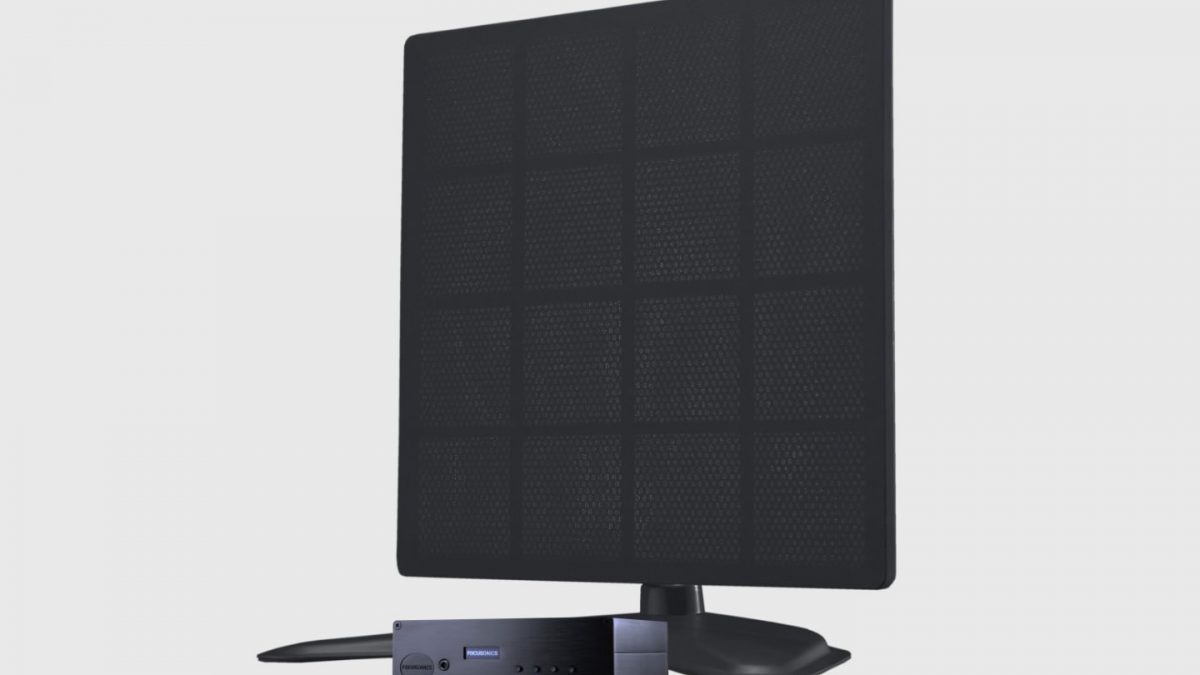Focusonics is a speaker that uses ultrasonic waves for sound reproduction, generating sound that is confined to a narrow beam that can reach tens of meters; in the beam the listener is immersed in music or speech while just steps away no sound can be heard.
Vilnius, Lithuania – April 9, 2019 – Neurotechnology today announced the launch of its new parametric array speaker, Focusonics Model A. Unlike conventional speakers that spread sound evenly, the Focusonics speaker uses ultrasonic waves to generate a directional sound that is confined to a narrow beam. The Focusonics speaker is ideal for use in a variety of situations where sound reproduction needs to be localized to a certain area while quiet is maintained elsewhere – from promotions in retail showrooms, galleries and trade shows to targeted public address and warning systems.
“The Focusonics speaker generates ultrasonic waves that are modulated with an audio signal,” said Dr. Osvaldas Putkis, research engineer and project lead at Neurotechnology. “As the ultrasonic waves travel through air they de-modulate and sound can be heard, however the diffraction of ultrasonic waves is much smaller than audio frequency waves, so the sound coming from the Focusonics speaker is constrained to a narrow beam. To the listener, it feels as if the sound is generated in the air just in front of you, creating a feeling of immersion and surround sound.”
A focused way to advertise, display and alert using sound
The Focusonics speaker can be used in retail showrooms and exhibitions for innovative advertising purposes. The speaker can be installed above the shelf of a specific product, transmitting relevant information solely to the customers who come close to the shelf while leaving other customers undisturbed. In museums and exhibitions, the speaker can be mounted above artwork to relay relevant information to interested visitors while maintaining the general quiet of the space.
The beam of the Focusonics speaker attenuates very little with distance and can be used to attract the attention of people from a significant interval away. For example, the speaker can be used to inform people at security check points about what to remove from their luggage or transmit warning messages specifically to people who cross the safety line on a train platform.
A source for sound and multimedia innovation
The speaker is also unique in that it can also be used to produce “virtual source” effects. If the speaker is directed toward a surface, for instance an LCD display, the sound beam will reflect from it and the sound will appear to emanate from the display itself rather than the speaker. Therefore, it is possible to make things like displays, holograms or paintings have a voice that speaks for creative advertising and presentation purposes.
Custom solutions combine sound and AI technologies
Building on extensive experience in developing computer vision applications, Neurotechnology can provide custom solutions using the Focusonics speaker in combination with person detection and recognition for applications such as personalized advertising, personalized greeting or direction services or automated warning systems. For example, a camera can be used to detect a person passing by or entering a shop, determine the person’s attributes such as sex, age and mood, and the Focusonics speaker can then be used to transmit a personalized greeting or advertising message that is beamed directly to the person’s location.
The Focusonics Model A speaker is based on Neurotechnology’s patent-pending ultrasonic transducer technology. To learn more and purchase Focusonics Model A, visit www.focusonics.com.
About Neurotechnology
Neurotechnology is a developer of high-precision algorithms and software based on deep neural networks and other AI-related technologies. The company was launched in 1990 in Vilnius, Lithuania, with the key idea of using neural networks for various applications, such as biometric person identification, computer vision, robotics and artificial intelligence. Since the first release of its fingerprint identification system in 1991, the company has delivered more than 200 products and version upgrades. More than 3,000 system integrators, security companies and hardware providers in more than 140 countries integrate Neurotechnology’s algorithms into their products. The company’s algorithms have achieved top results in independent technology evaluations, including NIST MINEX, PFT, FRVT, IREX and FVC-onGoing. Neurotechnology’s Ultrasound Research Group was created in 2014 for the research and development of ultrasound-related products for ultrasonic particle manipulation, directional parametric array speakers and other ultrasonic technologies.
Media Contact
Jennifer Allen Newton
Bluehouse Consulting Group, Inc.
+1-503-805-7540
jennifer (at) bluehousecg (dot) com

